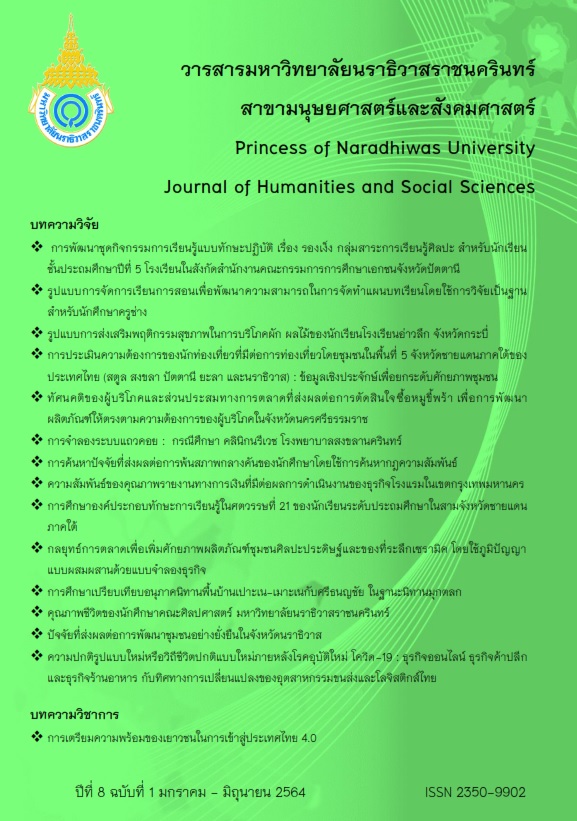Simulation of Queuing Systems: A case study of the gynecological clinic, Songkhlanagarind hospital
Main Article Content
Abstract
The research proposed to improve the queuing systems and investigated the system effectiveness by implementing the model systems in 7 gynecological clinic units, Songkhlanagarind hospital. The first-come-first-serve (FCFS) queuing model was implemented in order to reduce patients’ waiting time. The data were collected from a sample of 354 people, using a convenient sample selection method, selected from a population of 4,500 people. The collected data included the personal data and the time the patient was admitted in service unit until the patient leaves the unit between 01 October and 31 October 2019, only on working days for a total period of 22 days. The data were used to develop the queuing systems with Arena Simulation program.
The results showed that the queuing system model of gynecological clinic unit at Songkhlanagarind hospital were implemented in total 5 patterns which included one original pattern and 4 new developed patterns. It appeared that the third new pattern was the most efficient. The third new pattern required to change service time of medical practitioners and nurses in appointment and prescription section from the original service time (9:00 to 12:00) to the new service time (8:30 to 12.00) and requested an additional medical practitioner and two additional nurses; each located in screening section and appointment/prescription section. This helped fasten patients’ waiting time from 58.29 to 51.05 minutes. The reduction percentage of waiting time was 12.42 pecent, and the average of service time was reduced from 102.80 to 96.49 minuntes, approximately 6.14 percent reduction.
Article Details

This work is licensed under a Creative Commons Attribution-NonCommercial-NoDerivatives 4.0 International License.
References
กัลยา วานิชย์บัญชา. (2557). การวิเคราะห์เชิงปริมาณ (พิมพ์ครั้งที่ 3). กรุงเทพฯ: คณะพาณิชยศาสตร์และการบัญชี จุฬาลงกรณ์มหาวิทยาลัย.
จิราวรรณ จันทร์สุวรรณ, นิกร ศิริวงศ์ไพศาล, และวนัฐฌพงษ์ คงแก้ว. (2562). การจำลองสถานการณ์เพื่อเพิ่มประสิทธิภาพการให้บริการของแผนกขนย้ายผู้ป่วย: กรณีศึกษา โรงพยาบาลสงขลานครินทร์. วารสารไทยการวิจัยดำเนินงาน, 7(1), 25-35.
นเรศ อินทรกำแหง ณ ราชสีมา, เกรียงไกร อรุโณทยานันท์, และอรรถวิทย์ อุปโยคิน. (2563). การพัฒนาแบบจำลองอุปสงค์และการจราจรของลิฟต์โดยสารในบริบทโลจิสติกส์โรงพยาบาล. การประชุมวิชาการวิศวกรรมโยธาแห่งชาติ ครั้งที่ 25, ชลบุรี
ประสพชัย พสุนนท์. (2557). การกำหนดขนาดตัวอย่างตามแนวทาง Krejcie and Morgan (1970) ในการวิจัยเชิงปริมาณ. วารสารวิชาการศิลปศาสตร์ประยุกต์, 7(2), 112-125.
ปริตรา มั่นเหมาะ, และธนัญญา วสุศรี. (2562). การจำลองสถานการณ์เพื่อลดเวลารอคอยของผู้ป่วย แผนกผู้ป่วยนอก โรงพยาบาลชุมชนจังหวัดสุพรรณบุรี. วารสารเภสัชศาสตร์อีสาน, 5(2), 51-62.
โรงพยาบาลสงขลานครินทร์. (2563). ฐานข้อมูลคอมพิวเตอร์เครือข่ายอัตโนมัติของโรงพยาบาล สงขลานครินทร์.
สำนักงานสถิติแห่งชาติ. (2562). เทคนิคการสุ่มตัวอย่างและการประมาณค่า. สืบคนเมื่อวันที่ 22 สิงหาคม 2563, จาก http://service.nso.go.th/nso/nsopublish/Toneminute/files/55/A3-16.pdf
Aliyu, A. I., Sulaiman, T. A., & Yusuf, A. (2015). Modeling and Simulation Analysis of Health Care Appointment System using ARENA. International Journal of Science and Advanced Information Technology, 4(1), 1-7.
Fleck, L. M., & Murphy, T. F. (2018). First Come, First Served in the Intensive Care Unit: Always?. Cambridge Quarterly of Healthcare Ethics, 27(1), 52–61.
Gomes, A. M., Vieira, P. S., & Reis, A. D. C. (2017). Simulation of Operational Processes in Hospital Emergency Units as Lean Healthcare Tool. Independent Journal of Management & Production, 8(5), 812-827.
Khlie, K., & Abouabdellah, A. (2015). Modelling and Simulation of the Patient Pathway with Arena: Case of the Mother-child Hospital at Marrakech. in Xeme Conference Internationale: Conception et Production Integrees, Tanger, Morocco: HAL.
Kelton, W. D., Sadowski, R. P., & Zupick, N.B. (2015). Simulation with Arena (6th ed.). New York, NY: McGraw-Hill.
Keshtkar, L., Salimifard, K., & Faghih, N. (2015). A Simulation Optimization Approach for Resource Allocation in An Emergency Department. QScience Connect, 8, 1-11.
Sapsombat, W. & Roengsumran, A. (2019). A Needs Assessment Study to Improve the Quality of the Thailand National Test. ASEAN Journal of Education, 5(1), 33-43.


